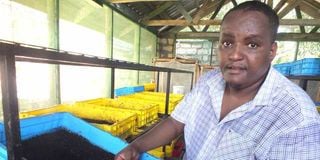
Paul Murage in his Pwani Fish Farm and Hatchery in Mtwapa, Kilifi County.
After graduating from United States International University – Africa (USIU-A) with a Bachelor's degree in business administration, Paul Murage never looked for a white-collar job.
Instead, Murage, now 44, worked in the family construction business for a few years before venturing into aquaculture.
Before long, Murage had set up Pwani Fish Farm and Hatchery in Mtwapa, Kilifi County.
The farm produces tilapia, catfish and ornamental fish fingerlings for sale.
“I got into aquaculture in 2013 after a misfortune. I got some money from an insurance company when my car was involved in an accident,” Murage says.
“I put the Sh300,000 into aquaculture. Before that, I had tried a hand in aquaculture but failed." The fish in the pond he had built died.
Instead of getting discouraged, Murage thought of rearing fish, but in a different way.
“That is how I got into aquaculture,” he says, adding that it was more of a hobby.
Murage says his mother used to buy him aquariums when he was a boy.
What motivated him to get more involved in aquaculture was the support of his parents and siblings.
“The fingerlings produced here are for sale, not for consumption. The farm also has common goldfish, black mollies and Koi carps. Our capacity in a month is 150,000 to 200,000 fingerlings. That, however, is when everything is constant and when we have orders,” he says.

Fish in one of the concrete ponds at Pwani Fish Farm and Hatchery.
Murage has five liner ponds and several concrete ponds. He also has five tilapia breeding tanks and 30 smaller ponds.
His farm has avoided the recirculating aquaculture system (RAS).
“We took the natural route. The ponds are designed in a way to give us the fries needed without necessarily resorting to RAS,” he says.
He bought his first batch of fingerlings in Sagana, Kirinyaga County. Murage also imports YY (male only) fingerlings from a company called Til-Aqua in the Netherlands.
“We get commercial feeds mostly from Nairobi. The farm also uses black soldier flies to supplement the feeds. We get them from the market,” he says.
“The black soldier fly has helped us cut production costs by about 50 percent.”
He feeds his fish in the morning, afternoon and evening.
Keeping predators away from his fish is one of the farm's biggest challenges.
Murage has put up shade nets to keep birds away from the fish.
“The market for ornamental fish is huge but Kenya has not tapped it well. That is why we are making brooders for fingerlings,” he says.
A catfish and tilapia fingerling at Murage's farm sells for Sh10. An inch of common goldfish costs Sh150, while the same for Koi carp costs Sh350 to Sh400.
Read: Physics of fish farming
Murage tells those who want to start fish farming to be resilient, determined and focused.
“Aquaculture is about water quality. If you do not invest in quality cold water, you will lose your fish,” he says.
“It will be a crisis if the water is dirty and you are not managing your fish properly."
His dream? To expand the business and start using RAS at the farm.
“It is expensive, but once we begin RAS, we will produce as many as a million fingerlings a month. Resources are available, so ours is just to expand the business,” the farmer says.










